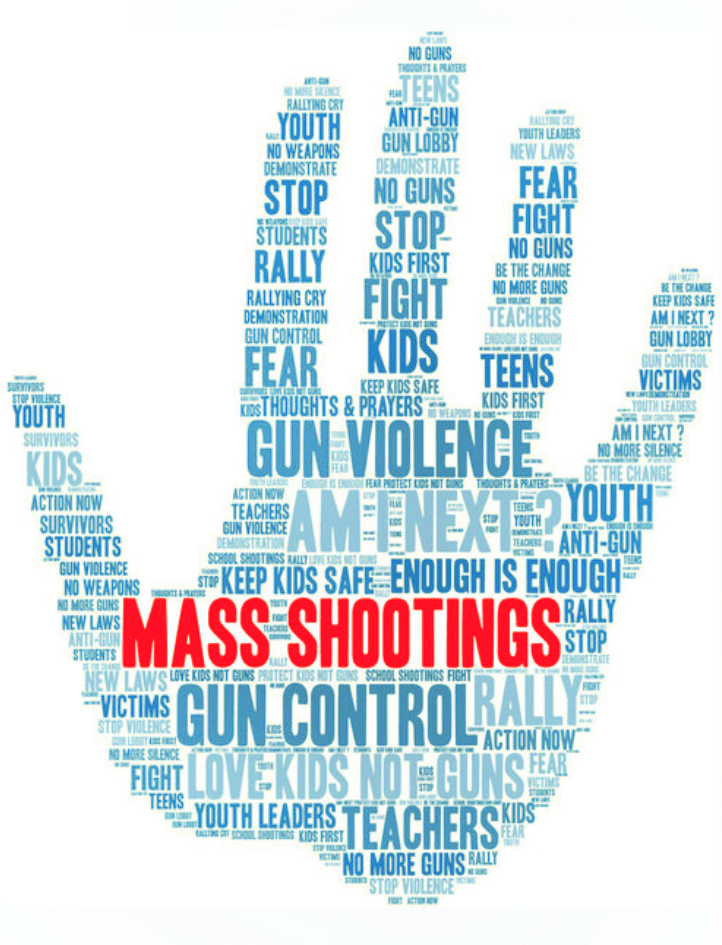 We’re at the grocery store, we’re on our way to pick the kids up at school, we’re at the doctor’s office waiting for an appointment– and because we carry a device that keeps us up-to-the-minute on whatever is happening anywhere in the country, we get the news. “Not again,” we say to ourselves.” Not another mass shooting.” It feels like another punch to our gut, bringing up instant memories of previous communities devastated by a single shooter with an assault weapon. We re experience the trauma and grief of other losses, of scores of innocent loved ones, murdered in a matter of a seconds, minutes.
We’re at the grocery store, we’re on our way to pick the kids up at school, we’re at the doctor’s office waiting for an appointment– and because we carry a device that keeps us up-to-the-minute on whatever is happening anywhere in the country, we get the news. “Not again,” we say to ourselves.” Not another mass shooting.” It feels like another punch to our gut, bringing up instant memories of previous communities devastated by a single shooter with an assault weapon. We re experience the trauma and grief of other losses, of scores of innocent loved ones, murdered in a matter of a seconds, minutes.School shootings are a form of terrorism, with far-reaching consequences beyond the short period of time in which they occur and well beyond the immediate communities where they happen. School shootings threaten every child’s sense of safety, every parent’s need to provide a sense of security for their children. And each time they occur anywhere in the US they activate our grief from previous ones. According to the Washington Post the Federal government doesn’t track school shootings, but in the Post’s tracking, they have concluded that 311,000 students have been exposed to school violence since Columbine, at 331 schools. There have been 24 acts of gun violence in schools so far in 2022.
Daniel was the name of one of the children who died at Sandy Hook Elementary School nearly 10 years ago. (December 14, 2012). I know his name because I get texts and emails from his father often, particularly when there is another school shooting and other children lose their lives while attending school. Like many of the people who have lost loved ones to gun violence, Daniel’s father, Mark Barden, used his own grief to honor his son’s life by starting an organization, The Sandy Hook Promise, working towards a time when other kids will not lose theirs in this same horrific manner.
With each new episode of carnage my mind goes back to the one I had so hoped would be the last one-Marjory Stoneman Douglas High School in Parkland FL (February 14, 2018.) A 19-year-old man had opened fire on students and staff, murdering 17 people and injuring 17 others. When a surviving student looked straight into the camera and in a voice of righteous anger said, “Do something. We’re just kids,” and a group of surviving students organized, and with some help from parents, confronted their local and national politicians. In less than two months they had joined with students from other schools and held a historic march for gun control. They called it March for Our Lives. I had felt hopeful that change was possible in this 20-year United States nightmare. (Other countries are not living with this terrorism.)
It turns out preventing gun violence in schools is complex, and politicians are trailing way behind the people on this issue, deadlocked in arguments that keep things at a stalemate. But thanks to organizations like Daniel’s dad founded, there are evidence-based approaches that are working in places where they are being put into practice. Here are some of the efforts we don’t hear enough about:
Teaching people to assess risky attitudes and behaviors in people in their communities before violence occurs is working.
Some states offer families the option of Extreme Risk Protection Orders so they can temporarily transform firearms from loved ones when they are in crisis. These programs save lives and protect Second Amendment rights.
Closing the Violent Hate Crimes Loophole in our background checks system is supported by 80 to 90 percent of the population and will keep guns out of the hands of people who should not have them.
Programs that encourage parents to keep firearms locked separately from ammunition protects young people from both accidental and intentional gun violence.
With that Stoneman-Douglas surviving teenager’s demand, “Do something. We’re just kids,” still ringing in my ears, I’ve decided to pick a program that is doing something and send that program some financial support. I’ll love it if you would join me. Because we can’t do everything, doesn’t mean we can’t do something.

